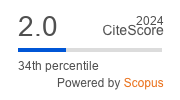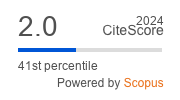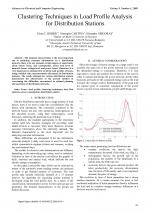| 1/2009 - 11 |
Clustering Techniques in Load Profile Analysis for Distribution StationsBOBRIC, E. C., CARTINA, G., GRIGORAS, G. |
| Extra paper information in |
| Click to see author's profile in |
| Download PDF |
Author keywords
load profile, clustering techniques, data flow analysis, power consumption, distribution station
References keywords
power(5), load(5), clustering(5)
Blue keywords are present in both the references section and the paper title.
About this article
Date of Publication: 2009-02-03
Volume 9, Issue 1, Year 2009, On page(s): 63 - 66
ISSN: 1582-7445, e-ISSN: 1844-7600
Digital Object Identifier: 10.4316/AECE.2009.01011
Web of Science Accession Number: 000264815300011
SCOPUS ID: 67749137135
Abstract
The demand characteristic is the most important one in analyzing customer information. In a distribution network, there is in any moment certain degree of uncertainty about busses loads, and consequently, about load level of network, busses voltage level, and power losses. Therefore, it is very important to estimate first of all the load profiles of buses, using available data (measurements effectuated in distribution stations). The results obtained for various distribution stations demonstrate the effectiveness of the present method in overcoming the difficulties encountered in optimal planning and operation of distribution networks. |
| References | | | Cited By «-- Click to see who has cited this paper |
| [1] Load profiles and their use in electricity settlement, Electricity Association, Publisher UKERC, 1997
[2] "Handbook of Applied Multivariate Statistics and Mathematical Modelling", Edited by: Howard E.A. Tinsley and Steven D. Brown ISBN: 978-0-12-691360-6 [PermaLink] [3] Gh. Cartina, Gh. Grigoras., E.C. Bobric, "Clustering Techniques in Load Analyse", Proc. of the International Power Systems Conference, PSC'05, 2005, Timisoara, Romania, pp. 123-130 [4] R.F. Chang, C.N. Lu, "Load profiling and its applications in power market", Power Engineering Society General Meeting, 2003, IEEE Volume 2, 13-17 July 2003, [CrossRef] [Web of Science Times Cited 5] [5] C. Nitu, A. S. Dobrescu, "The Role of Weather Indicators in Energy Consumption", Advances in Electrical and Computer Engineering, Suceava, Romania, ISSN 1582-7445, No 1/2008, volume 8, pp. 17-20 [CrossRef] [Full Text] [Web of Science Times Cited 2] [SCOPUS Times Cited 3] [6] JMP Statistics and Graphics Guide: Version 3, SAS Institute Inc., Cary, NC, USA, 1999 [7] A.K. Jain, M.N. Murty, P.J. Flynn, Data Clustering: A Rewiew, ACM Computing Serveys, 31, 264-323, 1999 [CrossRef] [Web of Science Times Cited 8232] [SCOPUS Times Cited 10900] [8] Clustering: An Introduction, Available: http://www.elet.polimi.it/upload/matteucc/Clustering/tutorial_html [9] Gh. Cartina, Gh. Grigoras, E.C. Bobric, "Clustering Techniques in Fuzzy Modeling. Power Systems Applications", Casa de Editura VENUS, Iasi, 2005 [10] P.E. Sinioros, C. Filote, A. Graur, M.G. Ioannides, "A New Real Time Method of the Instantaneous Active and Reactive Power Calculus", Advances in Electrical and Computer Engineering, Suceava, Romania ISSN 1582-7445, No. 1/2001, volume 1 (8), pp. 5-10 [11] M. Gavrilas, V.C. Sfintes, M.N. Filimon, "Identifying typical load profiles using neural-fuzzy models", 16th IEEE/PES Transmission and Distribution Conf. and Exposition, 2001, Atlanta, pp. 421-426 [CrossRef] [12] M. Gavrilas, Gh. Cartina, Gh. Grigoras, O. Ivanov, "Modelarea sarcinilor din retelele electrice", Editura PIM, Iasi, 2006 [13] D. Gerbec, S. Gasperic, and F. Gubina, "Comparison of Different Classification Methods for the Consumers' Load Profile Determination", 17th International Conference on Electricity Distribution, CIRED, Barcelona, vol. Session 6, 2003. Web of Science® Citations for all references: 8,239 TCR SCOPUS® Citations for all references: 10,903 TCR Web of Science® Average Citations per reference: 589 ACR SCOPUS® Average Citations per reference: 779 ACR TCR = Total Citations for References / ACR = Average Citations per Reference We introduced in 2010 - for the first time in scientific publishing, the term "References Weight", as a quantitative indication of the quality ... Read more Citations for references updated on 2025-06-01 02:03 in 29 seconds. Note1: Web of Science® is a registered trademark of Clarivate Analytics. Note2: SCOPUS® is a registered trademark of Elsevier B.V. Disclaimer: All queries to the respective databases were made by using the DOI record of every reference (where available). Due to technical problems beyond our control, the information is not always accurate. Please use the CrossRef link to visit the respective publisher site. |
Faculty of Electrical Engineering and Computer Science
Stefan cel Mare University of Suceava, Romania
All rights reserved: Advances in Electrical and Computer Engineering is a registered trademark of the Stefan cel Mare University of Suceava. No part of this publication may be reproduced, stored in a retrieval system, photocopied, recorded or archived, without the written permission from the Editor. When authors submit their papers for publication, they agree that the copyright for their article be transferred to the Faculty of Electrical Engineering and Computer Science, Stefan cel Mare University of Suceava, Romania, if and only if the articles are accepted for publication. The copyright covers the exclusive rights to reproduce and distribute the article, including reprints and translations.
Permission for other use: The copyright owner's consent does not extend to copying for general distribution, for promotion, for creating new works, or for resale. Specific written permission must be obtained from the Editor for such copying. Direct linking to files hosted on this website is strictly prohibited.
Disclaimer: Whilst every effort is made by the publishers and editorial board to see that no inaccurate or misleading data, opinions or statements appear in this journal, they wish to make it clear that all information and opinions formulated in the articles, as well as linguistic accuracy, are the sole responsibility of the author.



